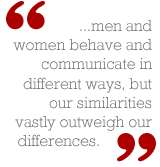










|
What Planet Are You From?
Men and women are raised, in most cultures, to seek different relationship goals and to bring different resources to their
interaction. Evolutionary psychologists theorize that our relationship roles reflect our ancestors' mating and child-rearing
strategies: males offered protection and provisions; women offered fertility and nurturing. Bringing these assets together in pair
bonds ensured best survival of the offspring.
Voilá: We, the descendants, have inherited relationship behaviors adapted to a world
that no longer exists. Women are no longer stuck for nine months at a time for every pregnancy; men need not obsess daily about
physically protecting their families from starvation or attack. We get modern "versions" of ancestral obsessions in heterosexual mating
today: men seek to offer power and ensure status in mating; women highlight or exaggerate the features youth and beauty. But for the
most part, the inherited and physical differences between human males and females are few (if important).
The big differences are less in biological maleness vs. femaleness than in social masculinity vs. femininity. The latter distinction is
about culture: families and society teach boys how to become masculine men, and instruct girls on how to become feminine women.
The lessons encompass everything from body language to school performance, from hair styles to shoe styles.
In our behavior, we can see much of this cultural distinction in the way we talk. Women talk differently from men. Is one or the other style better? We
won't make that argument here. But we will explore some of the differences, and what to make of them in exchanges between men and
women, especially (but not necessarily) in intimate relationships.
A popular series of self-help books began with the title Men Are from Mars, Women Are from Venus. The author, who is neither
a licensed psychologist nor researcher, proposed that the behavioral styles and very values of men and women are so different as to
suggest we came from different planets. This provocative metaphor continued in a few sequels and has become part of our conversation.
But is it true?
The short answer is "no": men and women behave and communicate in different ways, but our similarities vastly outweigh our differences.
Relationships researchers in fact point out that it's inaccurate to say men and women come from different gender cultures, much less from
different planets. In fact, the differences are so subtle that, if we are casting about for a comparison, researchers J. T. Wood and
Kathryn Dindia say it's more accurate to say that "men are from North Dakota, women are from South Dakota."
Gender Agendas
Despite the subtlety of gender differences, there may still seem to be a language barrier sometimes. In part this comes from learning
and valuing different relationship goals. For example, feminist psychotherapist Jean Baker Miller has argued that while both men and
women value power, they define it differently. Men are taught to define power in terms of exerting control or dominion; women
experience a sense of power in getting things done. As a result, when a man and woman talk about the same joint effort, they
may seem to have different agendas, as if they were talking about entirely different tasks:
She: "I'm trying to set this extra shelf up here. Can you give me a hand?"
He: "That's not the right way to install a shelf! I'll get my special tools and do it myself."
She: "No, I don't want to install it, I just need help lifting the board on to the supports."
He:"You asked me for help. I'm just trying to do it right."
She: "I'm not asking you to do it for me. I just want help with this one part of it, and I can get it
done just the way I want it."
She sees a simple task that he wants to complicate and take over. He hears her request, and offers to do it his way, the right way.
Each is being reasonable from his or her perspective, yet seems unreasonable to the other.
Linguistic scholar Deborah Tannen has written extensively about how different goals lead to gender differences in how we speak. In
her book That's Not What I Meant: How Conversational Style Makes or Breaks Relationships, Tannen included a chapter on gender
differences in conversation. Subsequently, she was overwhelmed with mail from readers, who especially sought additional information to
explain the problems they encountered in their own relationships.
Tannen responded by devoting an entire book to the subject, That's Not What I Meant: Women and Men in Conversation. Tannen says her own research
shows that men and women use language and conversation for broadly different purposes. Men tend to use conversation to give and get information, in order to be best equipped to achieve
power and status. In contrast, women use conversation to make a connection to others, in order to establish closeness.
For example, a woman might ask a the man in her life a question, in part just to have a conversation, to see where it goes and to
spend time talking with each other. But the man takes her question at face value, answers it if he has the information she is
requesting, and is satisfied to terminate the conversation there. Frustrated, she may persist in trying to have a conversation, and he
may become frustrated that she does not accept his answer:
She:"Look at that sky! It's clouding up. Do you think it will rain?"
He: "Weather forecast says only 30% chance of precip this weekend."
She: "I'd hate to have it rain on Bill and Sue's wedding tomorrow."
He: "I just said, most likely it won't rain."
She: "But look at those clouds! Don't you think...?"
He: "I've told you the forecast. Didn't you hear me?"
Alternatively, the man may request information from a woman, only to get a response that seems to avoid giving a straight answer:
He: "What time are your parents expecting us to be at their place?"
She: "Well, they know we have to drive through town and that means bad traffic."
He: "So what time are they expecting us?"
She: "It's not a formal dinner or anything, so if we don't get there when my sister's family does,
that's not a problem."
He: "Six o'clock, seven?"
She: "Remember, it starts to get dark already at five! I know you hate to drive in the dark, so we
shouldn't leave here too late."
He: "What time do they want us there?!"
She: "It says right on the invitation, seven-thirty! You don't have to yell!"
She never quite answers his question, despite his repetitions, perhaps because she wants to talk about the upcoming trip. His
question is, for her, an opportunity to talk about her concerns about visiting her family, not just a request for simple information.
Tannen notes that neither gender's agenda is more valuable. We need both information and connectedness in order to survive and
thrive. Men need to learn to value connectedness, to hear that request in women's speech, and to respond to it. Likewise, women
need to value information for its own sake, to recognize and respond to simple informational requests. The first step in learning each
other's language is recognizing that we do indeed have different goals, at least sometimes. We don't mean to thwart or irritate each
other. With motivation and practice, we can each get better at receiving and even sending in the other's language.
Gender Styles
Speaking of learning each other's language, style is another way in which men's and women's languages differ. In the third vignette
opening this lesson, Tim and Deb debate whether and how each says "I love you" to the other. Deb "says the words," and wants Tim to do
the same. For Tim, actions are what matter; he washes her car for her; so why does she habitually make him tuna for lunch, which she
knows he dislikes? Each seems to be communicating -- both sending and receiving -- in a style the other doesn't recognize and won't reproduce.
Researchers distinguish between these two styles an expressive
versus instrumental. Deb's language is expressive; she says "I love you," she greets her friends with hugs,
asking Time to "say the words." In contrast, Tim's style is instrumental. He uses actions to do the talking: washing Deb's car
because he loves her; helping friends move to a new apartment; interpreting tuna as a sign that Deb disregards his lunch
preferences.
These differences could cause a wide gulf between partners, one that is difficult to bridge. Fortunately, research
indicates that while men tend to be taciturn and instrumental, both men and women value expressive language -- talking and dealing with
feelings -- as more important in intimate relationships. Men and women agree that communicating affection and respect for each other
are critical to maintaining closeness, although in less intimate contexts men prefer to send and receive "action" and "how to" talk
with others.
Conclusions
Communication is "the stuff" that relationships are made of. Perversely, successful communication is not something we are born to
do well. We have the tools and materials to communicate well with close others, but our efforts can be done in by wrong assumptions,
bad timing, and conflicting styles. Fortunately, relationship communication is increasingly well researched. The field of
communication studies makes up an ever greater part of the multidisciplinary field of close relationships. Working with
psychologists, communication researchers offer concrete advice about how individuals can become clearer senders and more empathetic
receivers.
Next Session
The next lesson in this series focuses in particular on common relationship problems, and how to solve them. As we shall see,
communication accounts for many of the processes involved in both healthy and troubled intimacy. Keeping the lines open, being honest,
maintaining appropriate pacing, and recognizing the centrality of communication to intimacy can get relationships off to the best start
for preventing problems in the first place.

|



